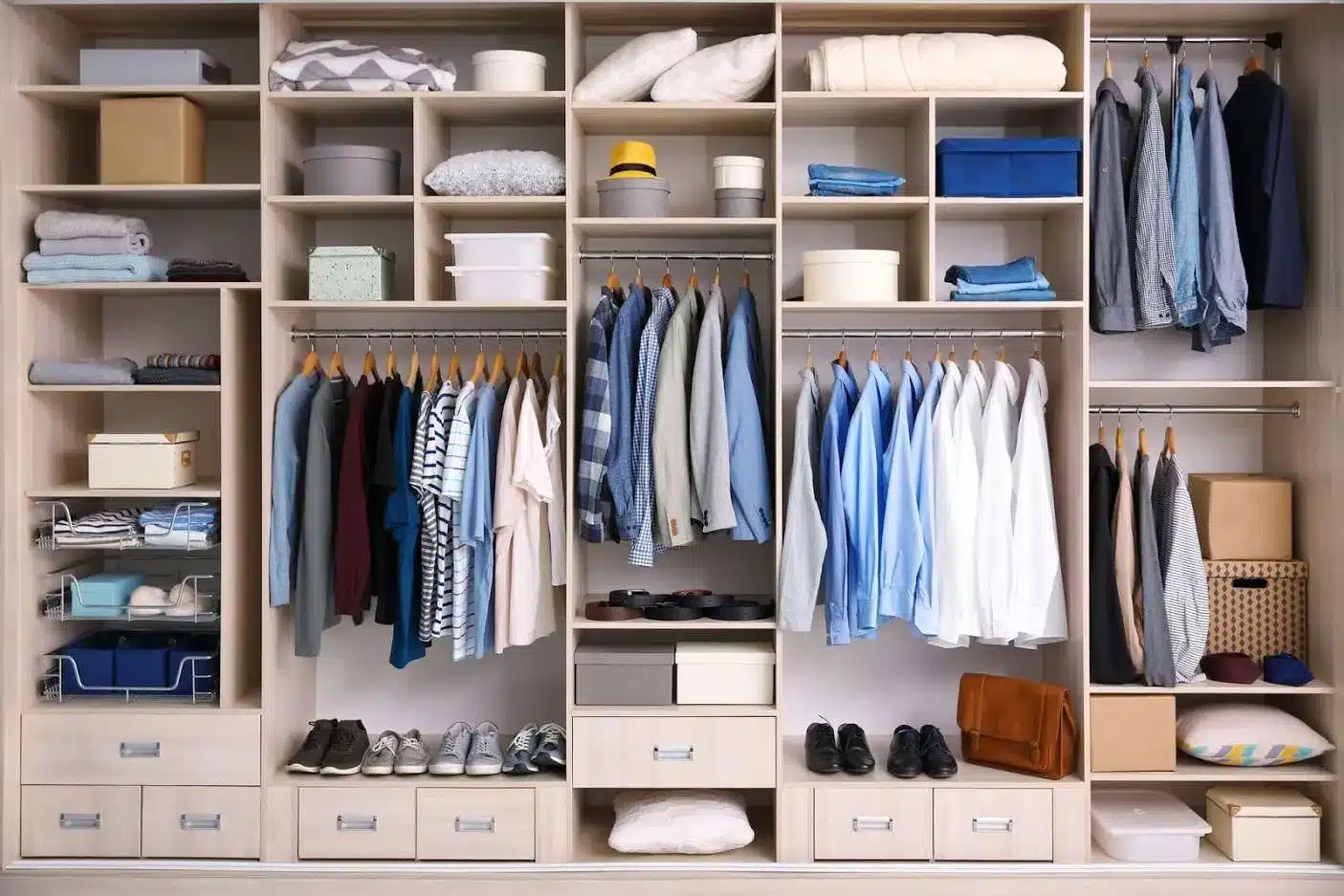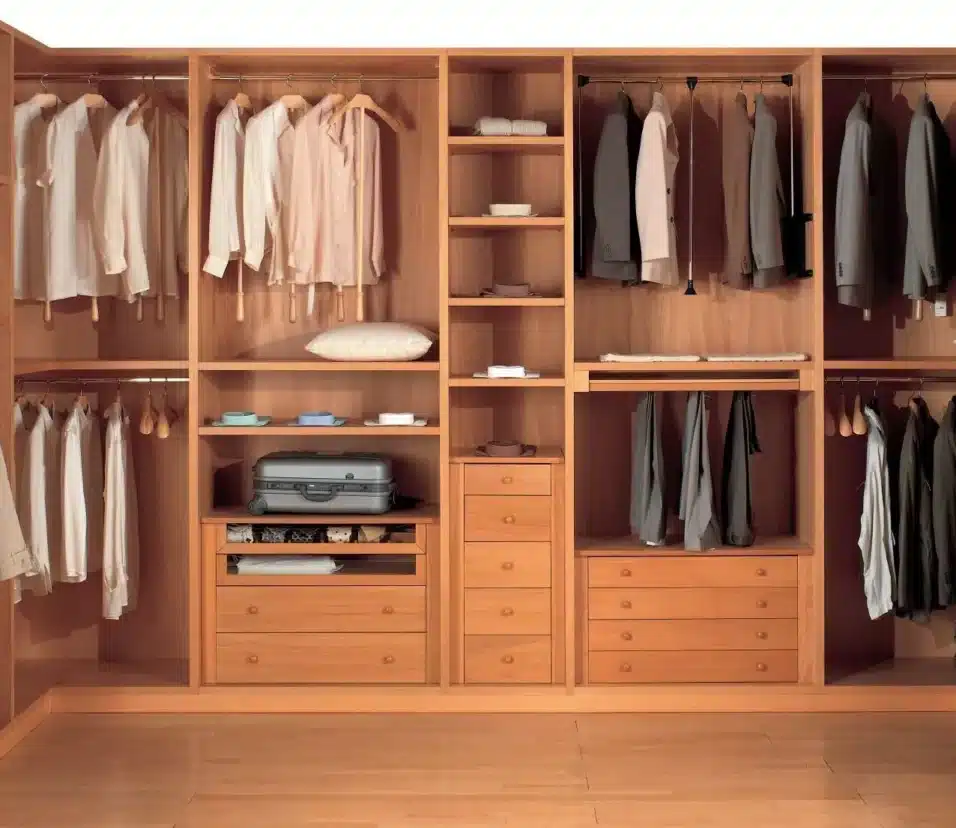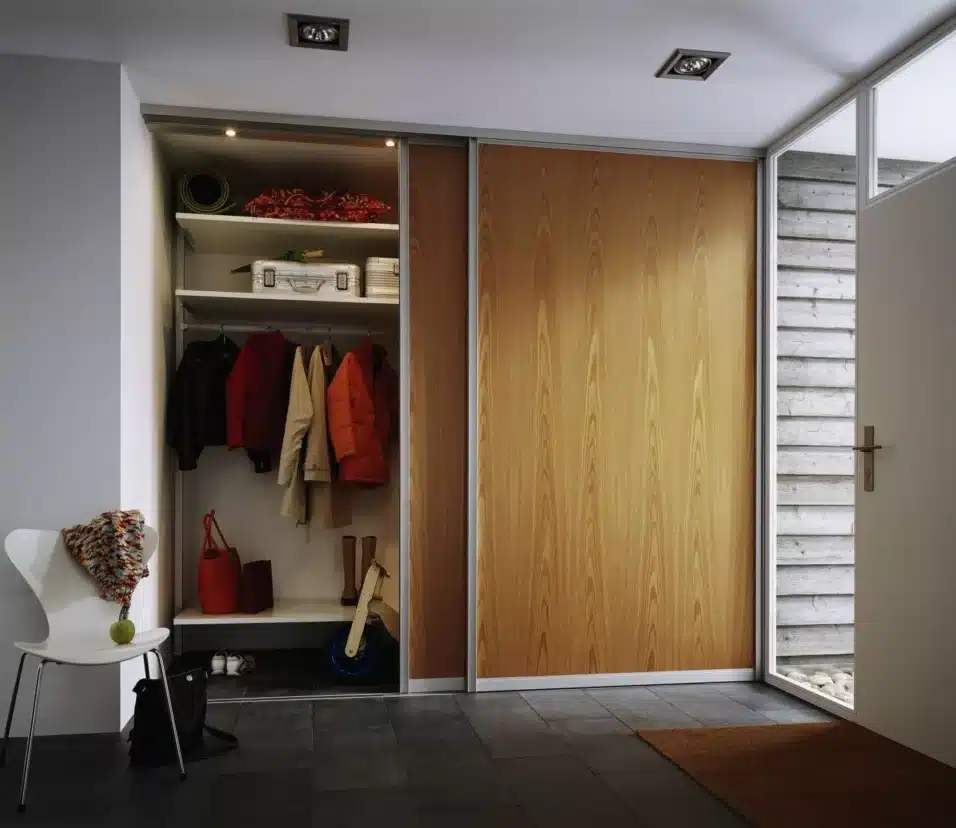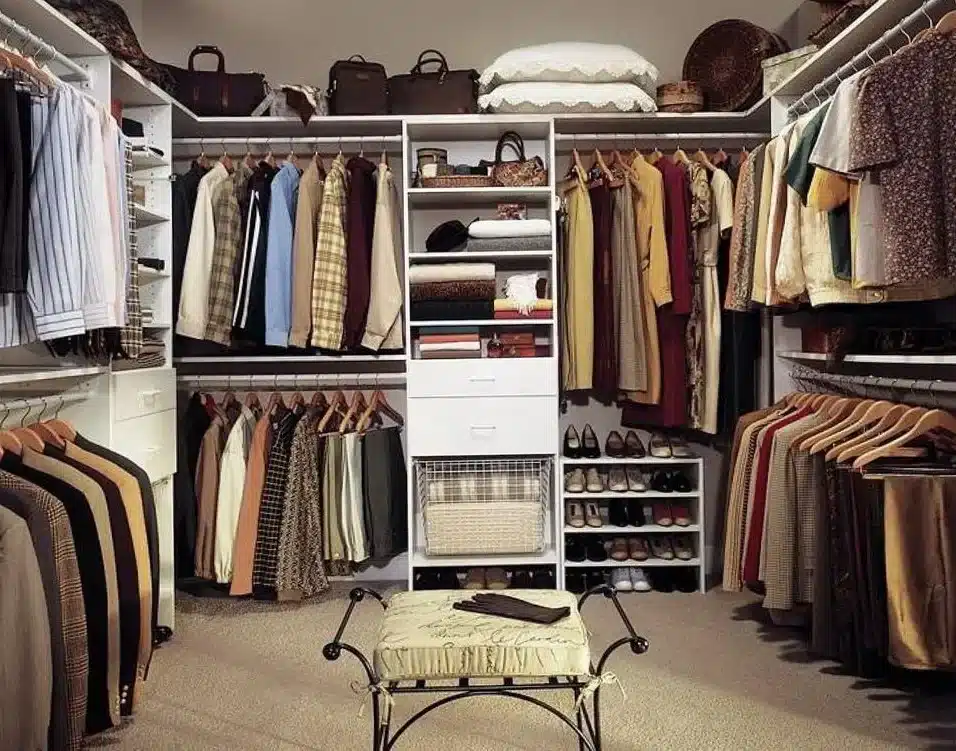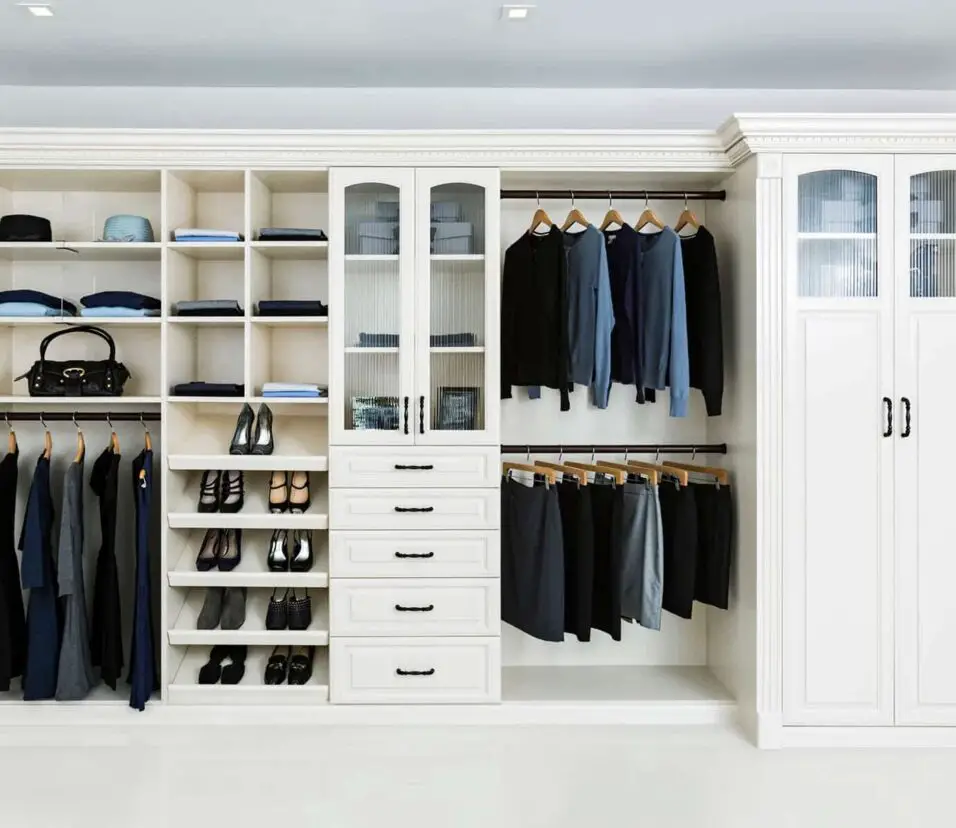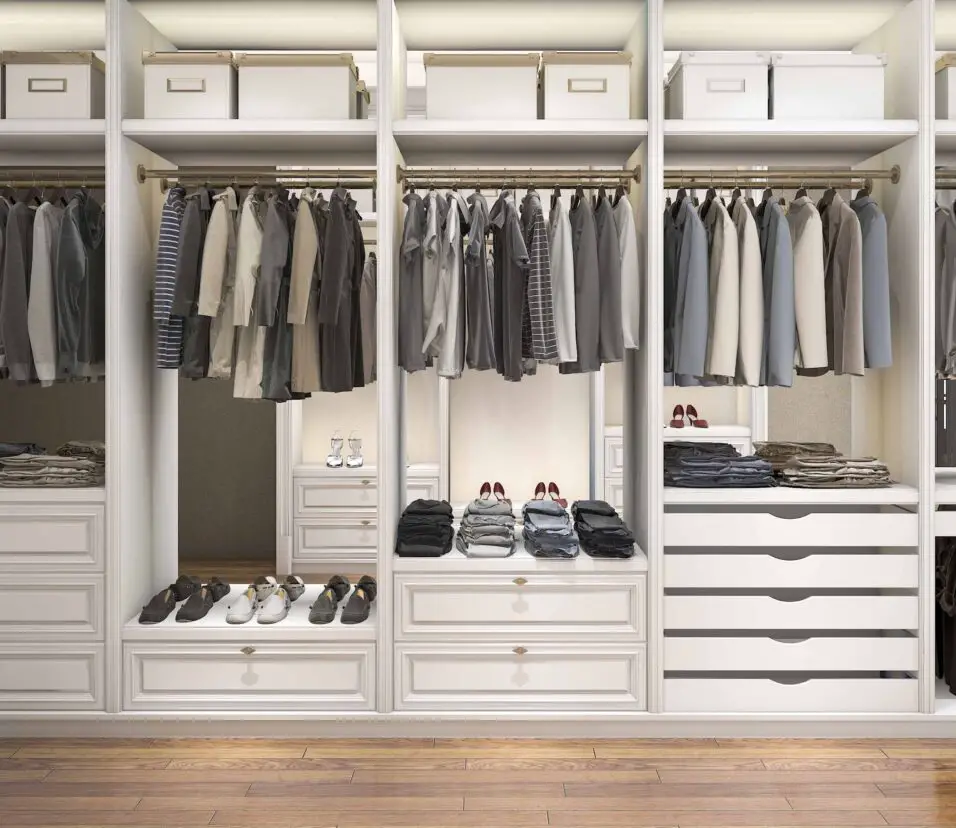How To Organize Wardrobe Without Hangers
Introduction
How To Organize Wardrobe Without Hangers: Maintaining an organized wardrobe is a cornerstone of a well-managed living space, yet achieving this orderliness doesn’t always necessitate the use of traditional hangers. Whether you’re dealing with limited hangers, specific clothing items that can’t be hung, or you’re simply seeking an alternative approach, learning how to organize a wardrobe without hangers can be a game-changing endeavor. By exploring inventive solutions and maximizing available space, you can effectively arrange your garments while ensuring they remain wrinkle-free and easily accessible.
This guide delves into creative strategies for arranging clothing items in a hanger-free environment. From utilizing shelves and drawers to innovative folding techniques, you’ll discover a plethora of techniques that cater to various clothing types, sizes, and storage spaces. By embracing these alternatives, you can transform your minimalist wardrobe into a haven of organization, where every piece of clothing has its designated place, making dressing up each day an effortless and enjoyable experience.
In the following sections, we’ll explore step-by-step methods and expert tips to help you achieve a meticulously organized wardrobe without relying on traditional hangers. Whether you’re revamping your closet, optimizing limited space, or exploring sustainable storage options, this guide is your compass to navigating the world of hanger-free wardrobe organization.

How do I organize my closet without hangers?
Install more shelving or drawers in your closet if you need it.
1.Add a shelving unit to your closet.
2.Hang floating shelves in your closet or armoire.
3.Put a bookcase in your closet for more shelving.
4.Place a dresser or plastic drawers in your closet.
5.Hang hooks and baskets against the wall. X Expert Source Ashley Moon, MA
Organizing your closet without using hangers requires a bit of creativity and thoughtful planning. Here are some effective strategies and tips to help you achieve a well-organized wardrobe without relying on traditional hangers:
Folding Techniques:
- KonMari Folding: Utilize the KonMari method by folding clothes into neat rectangles and placing them vertically in drawers or on shelves. This technique maximizes visibility and minimizes wrinkles.
- Rolling: Roll up clothes like t-shirts, jeans, and casual pants to save space and make them easily accessible.
Shelving:
- Use shelves to stack folded clothes, ensuring each stack is neatly arranged and easily reachable.
- Group similar items together, such as stacking all your jeans, sweaters, or workout clothes in dedicated sections.
Baskets and Bins:
- Invest in decorative baskets or fabric bins to hold items like socks, underwear, scarves, and accessories.
- Label bins for quick identification and easy retrieval.
Hooks and Pegs:
- Install hooks or pegs on the inside of closet doors or on walls to hang bags, hats, belts, and other accessories.
- Hang items you use frequently for easy grab-and-go access.
Shoe Storage:
- Use shoe racks or cubbies to organize your footwear neatly.
- Store shoes in clear plastic bins to keep them visible and protected.
Drawer Dividers:
- Use drawer dividers to separate and organize small items like underwear, socks, and ties.
- Keep items visible and easy to find by arranging them in rows.
Bulky Items:
- Fold larger items like blankets, hoodies, and sweatpants neatly on shelves.
- Use vacuum-sealed bags to compress bulky items, saving space.
Vertical Storage:
- Use hanging fabric shelves to store shoes, folded clothes, or accessories vertically.
- Utilize the vertical space in your closet to make the most of available room.
Regular Maintenance:
Regularly assess your closet and declutter items you no longer wear or need to maintain an organized space.
Color Coordination:
Organize folded items by color to create a visually pleasing and orderly display.
Remember that the key to organizing your closet without hangers is to think creatively and optimize the available space with alternative storage solutions. By customizing your approach based on your wardrobe and preferences, you can achieve a tidy and functional closet that suits your needs.
How do I organize my wardrobe inside?
Make more space inside your wardrobe by organising a system. Hang clothes in categories, then within that by sleeve length and colour for easy visibility. Position items worn often in a prominent, easy-to-reach spot, with those you wear less often (such as heavy jumpers) at the top of the wardrobe.
Organizing the inside of your wardrobe can greatly enhance its functionality and make getting dressed a more pleasant experience. Here’s a step-by-step guide to help you organize your wardrobe effectively:
Empty and Clean:
Start by completely emptying your wardrobe. Wipe down the shelves, rods, and any other surfaces to ensure they are clean and dust-free.
Sort and Declutter:
Sort through your clothing items, shoes, and accessories. Keep what you love, fits well, and is in good condition. Donate or discard items you no longer wear or need.
Categorize:
Categorize your clothing items into groups such as shirts, pants, dresses, sweaters, etc. This will make it easier to organize and find items later.
Choose Your Organization Method:
Decide on the organization methods that work best for you based on the available space and your preferences. Consider techniques like folding, stacking, using baskets, and utilizing drawer dividers.
Maximize Hanging Space:
Hang items that wrinkle easily or are best displayed on hangers. Use matching hangers to create a clean and cohesive look.
Folding Techniques:
- Fold clothes like t-shirts, jeans, and sweaters using methods like KonMari folding or rolling.
- Arrange folded clothes on shelves or in drawers, grouping similar items together.
Drawer Dividers:
Use drawer dividers to separate and organize smaller items like socks, underwear, ties, and accessories. This keeps everything visible and easily accessible.
Shoe Storage:
- Use shoe racks, cubbies, or clear plastic containers to organize your shoes.
- Keep shoes you wear frequently within easy reach.
Utilize Baskets and Bins:
- Use decorative baskets or bins to store accessories, scarves, and belts.
- Label bins for quick identification.
Accessory Storage:
- Hang hooks or pegs on the inside of doors or walls to hold bags, hats, or jewelry.
- Install a pegboard for hanging and displaying accessories.
Color Coordination:
Arrange clothing items by color to create a visually appealing and organized display.
Regular Maintenance:
- Regularly review and declutter your wardrobe to keep it organized.
- Rotate seasonal items to ensure you have easy access to the appropriate clothing.
Evaluate and Adjust:
After using your organized wardrobe for a while, assess its effectiveness and make adjustments as needed.
By following these steps and customizing the organization methods to suit your personal style and needs, you can create a beautifully organized wardrobe that makes finding and selecting outfits a breeze.
What can you put on top of a wardrobe?
A basket, an interesting crate, something that is open on the top. Then fill it with quilts, wool plaid blankets, dried hydrangeas, ferns; anything textural. Simple and classic. If your large accessory doesn’t quite fill up the whole space, add something on either side.
The space on top of a wardrobe can be utilized for both functional and decorative purposes.
Here are some ideas for what you can put on top of a wardrobe:
Storage Baskets or Bins: Use decorative baskets or bins to store items like out-of-season clothing, accessories, or extra bedding.
Decorative Boxes: Place decorative boxes or containers on top to store smaller items and keep them organized.
Artwork or Decor: Display artwork, sculptures, or decorative items that complement the room’s aesthetic.
Plants: Add some greenery with potted plants or succulents to bring a touch of nature to the space.
Books: Arrange a stack of books or magazines on top of the wardrobe for a stylish touch.
Decorative Trays: Place a decorative tray with candles, vases, or other decorative accents for a polished look.
Mirrors: Lean a large mirror against the wall on top of the wardrobe to visually expand the space and add functionality.
Storage Boxes: Use storage boxes with lids to keep items out of sight while maintaining a tidy appearance.
Luggage or Suitcases: Store luggage or suitcases on top of the wardrobe to save space in other areas.
Woven Baskets: Place woven baskets on top for a rustic or bohemian look while providing additional storage.
Seasonal Decor: Change the decor on top of the wardrobe seasonally, such as adding festive decorations during holidays.
Personal Items: Store sentimental items or keepsakes that you want to keep safe and out of the way.
Blankets or Throws: Fold and neatly stack blankets or throws on top of the wardrobe for easy access.
Corkboard or Bulletin Board: Attach a corkboard or bulletin board to the wall above the wardrobe to pin up notes, photos, or inspiration.
Remember to keep the items balanced and proportional to the size of the wardrobe and the room. Whether you opt for functional storage solutions or decorative accents, the top of your wardrobe can contribute to the overall aesthetic and organization of your space.
Are wooden or plastic hangers better?
Unlike plastic and wire hangers, wood hangers are sturdy and won’t bend over time. Their strong design is better equipped at maintaining the shape of clothing, especially heavier items such as jackets, winter coats, and jeans.
Both wooden and plastic hangers have their own advantages and are suitable for different types of clothing and personal preferences. Here’s a comparison of wooden and plastic hangers to help you decide which might be better for your needs:
Wooden Hangers:
- Durability: Wooden hangers are generally more durable and long-lasting compared to plastic hangers. They can support heavier garments without bending or breaking.
- Aesthetics: Wooden hangers have a classic and elegant look that can enhance the visual appeal of your closet. They are often preferred for upscale or formal clothing.
- Shoulder Shape: Wooden hangers usually have a broader shoulder shape, which helps maintain the shape of garments like suits, jackets, and coats.
- Grip: The natural texture of wood can prevent clothes from slipping off the hangers, especially items with smooth or silky fabrics.
- Sustainability: Wooden hangers are biodegradable and more environmentally friendly compared to some plastic hangers.
- Closet Space: Wooden hangers are thicker and may take up slightly more closet space than slim plastic hangers.
Plastic Hangers:
- Affordability: Plastic hangers are generally more affordable than wooden hangers, making them a cost-effective choice for larger wardrobes.
- Variety: Plastic hangers come in a wide range of shapes, sizes, and colors, allowing you to choose options that best suit your clothing collection.
- Weight: Plastic hangers are lightweight, making them easy to handle and suitable for lightweight garments like t-shirts, blouses, and dresses.
- Space-Saving: Slim plastic hangers take up less space in your closet, allowing you to fit more clothes in a limited area.
Resistance to Moisture:
- Plastic hangers are less susceptible to moisture damage compared to wooden hangers, which can be important in humid environments.
- Travel-Friendly: Plastic hangers are easy to pack and carry for travel due to their lightweight nature.
Ultimately, the choice between wooden and plastic hangers depends on your priorities and the types of clothing you have. For formalwear and heavier garments, wooden hangers are an excellent choice. If you have a larger wardrobe, varying types of clothes, and want to save space, plastic hangers might be more practical. Some people even choose to have a combination of both types of hangers to cater to different clothing items.
Are plastic hangers better?
Plastic hangers are as good as wooden hangers in terms of versatility, but not so much in terms of sturdiness. So consider these hangers to be just a rung below wooden hangers. Almost everything that can be hung on plastic hangers can also be hung on wooden hangers, but not the other way round.
Plastic hangers can be a better choice in certain situations, depending on your specific needs and preferences.
Here are some reasons why plastic hangers might be considered better in certain circumstances:
Affordability: Plastic hangers are generally more affordable than wooden hangers. If you have a large wardrobe and need to purchase a significant number of hangers, plastic options can help you save money.
Variety: Plastic hangers come in a wide range of shapes, sizes, and colors. This variety allows you to choose hangers that best suit different types of clothing, such as dresses, shirts, and pants.
Weight: Plastic hangers are lightweight, making them easy to handle and maneuver. They are suitable for lightweight clothing items like t-shirts, blouses, and dresses.
Space-Saving: Slim plastic hangers take up less space in your closet compared to bulkier wooden hangers. This can be especially important if you have limited closet space.
Resistance to Moisture: Plastic hangers are less susceptible to moisture damage compared to wooden hangers. If you live in a humid environment, plastic hangers might be a better choice to prevent warping or mildew growth.
Travel-Friendly: Plastic hangers are convenient for travel due to their lightweight nature. You can use them to keep your clothes organized when packing for trips.
Customization: Some plastic hangers come with built-in features like hooks or clips for hanging accessories, which can help you keep your outfits coordinated and organized.
Durability for Certain Items: While plastic hangers might not be as durable as wooden hangers for heavier items like suits and coats, they can still adequately support most clothing items.
It’s important to consider your specific wardrobe, clothing collection, and preferences when choosing hangers. If you have a mix of lightweight clothing and are looking for an affordable and space-saving option, plastic hangers can be a practical choice. However, for more formal or heavy garments, wooden hangers might offer better support and aesthetics.
How to make a cheap closet organizer?
21 DIY Closet Organization Ideas – Best Closet Organizer Ideas
Using painted support boards and shelf boards, you can build two sets of shelves for your closet: one that sits at the bottom of your closet, and one that’s installed at the top. The shelves won’t get in the way of your clothes, and they’re excellent for storing small bins and shoes.
Organizing a minimalist wardrobe involves intentional curation, thoughtful organization, and a focus on quality over quantity. Here’s a step-by-step guide to help you create and maintain a well-organized minimalist wardrobe:
Declutter:
Start by decluttering your current wardrobe. Remove items you no longer wear, don’t love, or that no longer fit. Be honest about what truly adds value to your life.
Define Your Style:
Identify your personal style preferences and the types of clothing that make you feel confident and comfortable. This will guide your selection process.
Create a Capsule Wardrobe:
Consider creating a capsule wardrobe with a set number of versatile pieces that can be mixed and matched. Aim for around 30-40 items, including clothing, shoes, and accessories.
Invest in Quality:
Focus on high-quality, durable pieces that will stand the test of time. Choose well-made basics that can be paired with multiple outfits.
Stick to Neutral Colors:
Opt for a color palette of neutral tones such as black, white, gray, and beige. These colors are versatile and make it easier to mix and match.
Limit Trends:
While adding a few trendy pieces is fine, avoid overloading your wardrobe with items that might quickly go out of style.
Organize by Type:
Organize your clothing items by type (e.g., tops, bottoms, dresses) and then further categorize them (e.g., shirts, sweaters, jeans).
Folding Techniques:
Use efficient folding techniques, like the KonMari method, to maximize space and visibility in drawers and shelves.
Drawer Dividers:
Use drawer dividers to keep smaller items like underwear, socks, and accessories neatly separated.
Shoe Organization:
Store shoes on racks, shelves, or cubbies to keep them visible and easily accessible.
Accessories:
Keep accessories simple and minimal. Choose a few versatile pieces that complement your outfits.
Regular Maintenance:
Periodically reassess your wardrobe and remove items that no longer fit your style or no longer serve a purpose.
Mindful Shopping:
Before adding new items, consider whether they truly align with your style and needs. Choose pieces that enhance your existing wardrobe.
Quality over Quantity:
Focus on adding items that are versatile, well-made, and truly reflect your personal style.
Adapt as Needed:
Your minimalist wardrobe is a work in progress. Adapt it to changing seasons, events, and your evolving style preferences.
Remember, a minimalist wardrobe is about cultivating a collection of items that bring you joy, reflect your personal style, and simplify your daily choices. By prioritizing quality, versatility, and organization, you can create a wardrobe that is both functional and aesthetically pleasing.
How do I organize my messy wardrobe?
Sort Clothes by Garment Type & Color
together can also help simplify getting ready in the morning. Take things a step further and organize your pieces as specifically as possible. For example, sort professional camisoles by your blazers and your chunky sweaters near your long underwear – you get the idea.
Organizing a messy wardrobe can feel overwhelming, but with a systematic approach and some time set aside, you can transform it into an organized and functional space. Here’s a step-by-step guide to help you get started:
Set Aside Time:
Dedicate a block of time when you won’t be rushed to tackle the task. Depending on the size of your wardrobe, this could range from a couple of hours to a full day.
Empty Everything:
Take everything out of your wardrobe and lay it on your bed or a clean surface. This will give you a clear view of what you have and allow you to clean the wardrobe’s interior.
Sort and Declutter:
Create piles for items you want to keep, donate, sell, or discard. Be ruthless in evaluating each item’s usefulness and whether it fits your current style.
Clean and Repair:
While the wardrobe is empty, take the opportunity to clean the shelves, rods, and corners. Repair any damages, such as loose screws or broken parts.
Categorize:
Sort your clothing into categories (e.g., shirts, pants, dresses, accessories). This will help you organize them more effectively.
Use the KonMari Method:
Consider using the KonMari method, which involves holding each item and deciding whether it sparks joy. Only keep items that bring you happiness.
Invest in Storage Solutions:
Based on your wardrobe’s layout, invest in storage solutions such as shelves, hanging organizers, bins, and baskets to keep things organized.
Folding Techniques:
Learn efficient folding techniques to maximize space and visibility. Folding items neatly is key to an organized wardrobe.
Group Similar Items:
Group similar items together, such as stacking jeans with jeans and placing all your accessories in one area.
Use Vertical Space:
Make the most of vertical space by using hanging organizers, hooks, or pegs on the closet doors or walls.
Label and Categorize:
Label bins and baskets to clearly indicate what’s inside. This makes finding items easier and encourages maintenance.
Rotate Seasonally:
Consider rotating your wardrobe seasonally. Store out-of-season items in another location to free up space for current season items.
Maintain Regularly:
Regularly review your wardrobe to ensure it remains organized. Whenever you buy new items, try to follow a “one in, one out” rule to prevent clutter from building up again.
Stick to Your System:
The key to an organized wardrobe is consistency. Stick to the system you’ve created to keep things tidy in the long run.
Remember, organizing a messy wardrobe is a process that takes time and effort. Stay patient and focused, and the end result will be a beautifully organized space that makes getting dressed a breeze.
How do I build a classy wardrobe?
- Choose Neutral Colors. Neutral colours are the stepping stone to building your wardrobe the classy way.
- Simple Shapes. In order to look distinctive, you don’t need to go all over the board.
- Minimalism Is The Key. People tend to take minimalism in the wrong way.
- Stick To Your Personal Style.
Building a classy wardrobe involves curating a collection of timeless and versatile pieces that exude sophistication and style. Here’s a step-by-step guide to help you build a classy wardrobe:
Define Your Style:
Determine the style that resonates with you. Classic styles like minimalist, preppy, or modern chic often convey a sense of class and elegance.
Invest in Quality Basics:
Focus on high-quality basics that form the foundation of your wardrobe. These include well-fitting jeans, tailored trousers, crisp white shirts, and versatile blouses.
Choose Neutral Colors:
Opt for neutral colors like black, white, gray, navy, and beige. These colors are timeless, easy to mix and match, and create a sophisticated look.
Select Timeless Pieces:
Invest in pieces that transcend trends and remain stylish over time. A little black dress, a tailored blazer, and a classic trench coat are excellent choices.
Opt for Tailored Fits:
Ensure that your clothing items fit well. Tailored pieces look more polished and emphasize your body’s proportions.
Quality Over Quantity:
Prioritize quality over quantity. Invest in well-made pieces that will last longer, rather than buying numerous lower-quality items.
Accessorize Thoughtfully:
Choose accessories that complement your outfits without overpowering them. Classic accessories like pearl earrings, a quality watch, or a structured handbag can enhance your look.
Avoid Overly Trendy Items:
While some trends can be incorporated, avoid overly trendy pieces that may quickly go out of style. Opt for subtle and timeless embellishments.
Focus on Fabric:
Pay attention to the fabric of your clothing. Quality fabrics like wool, silk, cashmere, and cotton not only feel luxurious but also tend to age well.
Balance Patterns and Prints:
Incorporate subtle and classic patterns like stripes, polka dots, or houndstooth. Avoid overly bold or trendy prints.
Mix High and Low:
You don’t need to exclusively buy designer items. Mix high-end pieces with well-chosen budget-friendly options to create a balanced wardrobe.
Embrace Versatility:
Opt for pieces that can be dressed up or down, allowing you to create multiple outfits from a few key items.
Regularly Review and Edit:
Periodically review your wardrobe and remove items that no longer fit your style or that you no longer wear.
Confidence is Key:
Building a classy wardrobe is not only about the clothes you wear but also how you carry yourself. Confidence and good posture elevate any outfit.
Personal Touch:
Add a personal touch to your wardrobe with signature accessories or a specific color that reflects your individuality.
Remember, building a classy wardrobe is a gradual process. Take your time to curate pieces that truly resonate with you and stand the test of time. A well-thought-out wardrobe will help you feel confident, put-together, and effortlessly elegant in any situation.

Conclusion
Mastering the art of organizing a wardrobe without relying on traditional hangers offers a creative and resourceful approach to maximizing your storage space. By embracing alternative methods like folding, stacking, using hooks, and utilizing bins, you not only ensure efficient storage but also cultivate a clutter-free and accessible closet environment. This guide has provided insights into innovative techniques that cater to different clothing types, sizes, and preferences.
Organizing a wardrobe without hangers doesn’t just save space; it encourages intentional curation, simplifies daily choices, and promotes sustainable practices. Whether you’re dealing with a small closet, seeking an eco-friendly approach, or simply looking for ways to streamline your wardrobe, these strategies empower you to transform your closet into an organized haven that reflects your personal style and enhances your everyday routine.



